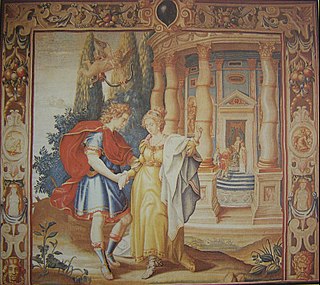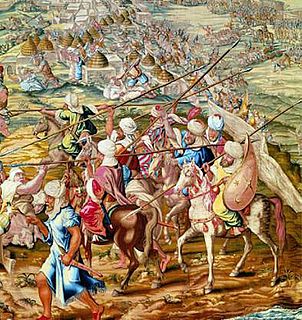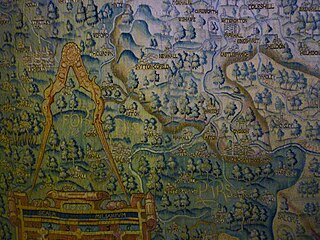 W
WAubusson tapestry is tapestry manufactured at Aubusson, in the upper valley of the Creuse in central France. The term often covers the similar products made in the nearby town of Felletin, whose products are often treated as "Aubusson". The industry had probably developed since soon after 1300 in looms in family workshops, perhaps already run by the Flemings that are noted in documents from the 16th century.
 W
WThe Beauvais Manufactory is a historic tapestry factory in Beauvais, France. It was the second in importance, after the Gobelins Manufactory, of French tapestry workshops that were established under the general direction of Jean-Baptiste Colbert, the finance minister of Louis XIV. Whereas the royal Gobelins Manufactory executed tapestries for the royal residences and as ambassadorial gifts, the manufacture at Beauvais remained a private enterprise. Beauvais specialised in low-warp tapestry weaving, although the letters patent of 1664, authorising the company and offering royal protection, left the field open for the production of high-warp tapestry as well.
 W
WBrussels tapestry workshops produced tapestry from at least the 15th century, but the city's early production in the Late Gothic International style was eclipsed by the more prominent tapestry-weaving workshops based in Arras and Tournai. In 1477 Brussels, capital of the duchy of Brabant, was inherited by the house of Habsburg; and in the same year Arras, the prominent center of tapestry-weaving in the Low Countries, was sacked and its tapestry manufacture never recovered, and Tournai and Brussels seem to have increased in importance.
 W
WThe Gobelins Manufactory is a historic tapestry factory in Paris, France. It is located at 42 avenue des Gobelins, near Les Gobelins métro station in the 13th arrondissement of Paris. It was originally established on the site as medieval dyeing business by the family Gobelin.
 W
WThe Moravská gobelínová manufaktura — MGM, is a tapestry manufactory located in the town of Valašské Meziříčí, in the Zlín Region of the Czech Republic. The manufactory has been involved in the area of handmade classical and artistic tapestries, restoring and also creating new pieces with modern themes for more than fifty years. It is considered the first tapestry manufactory in Czechoslovakia, and the only workshop of this kind in Moravia and Czech Silesia.
 W
WMorris, Marshall, Faulkner & Co. (1861–1875) was a furnishings and decorative arts manufacturer and retailer founded by the artist and designer William Morris with friends from the Pre-Raphaelites. With its successor Morris & Co. (1875–1940) the firm's medieval-inspired aesthetic and respect for hand-craftsmanship and traditional textile arts had a profound influence on the decoration of churches and houses into the early 20th century.
 W
WThe Mortlake Tapestry Works was established alongside the River Thames at Mortlake, then outside, but now on the edge of west London, in 1619 by Sir Francis Crane. It produced lighter, if vastly more expensive, decoration for rooms than the previously favoured Elizabethan wood panelling. King Charles I was a heavy investor and it prospered. The English Civil War disrupted all luxury goods businesses. Cromwell tried to help. Charles II imposed heavy duties on competitive imports, but the decline could not be reversed. It closed in 1704; some of the weavers continued to work privately.
 W
WThe family of de Pannemaeker or de Pannemaker were tapestry weavers from the Southern Netherlands, more or less equivalent to modern-day Belgium. Pieter de Pannemaeker, working from Brussels, was a celebrated weaver who, for European royalty, created tapestries resplendent with gold and silver threads, and expensive fine silks and woollen items. In 1520, Pieter de Pannemaeker commissioned the artist Bernard van Orley to make tapestry cartoons for his workshop. A surviving fragment depicts the Allegory of the Four Winds. Pannemaeker was court weaver to Margaret of Austria, Regent of the Southern Netherlands, who commissioned the Passion in four parts, and in 1523, she ordered an imposing dais made up of three tapestries, which later featured in the abdication ceremony of Emperor Charles V.
 W
WThe Royal Tapestry Factory is a manufacturing plant located in Madrid, Spain, which was founded in 1720.
 W
WSheldon tapestries were produced at Britain's first large tapestry works in Barcheston, Warwickshire, England, established by the Sheldon family. A group of 121 tapestries dateable to the late 16th century were produced. Much the most famous are four tapestry maps illustrating the counties of Gloucestershire, Worcestershire, Oxfordshire and Warwickshire, with most other tapestries being small furnishing items, such as cushion covers. The tapestries are included in three major collections: the Victoria and Albert Museum, London; the Metropolitan Museum of Art, New York; and the Burrell Collection, Glasgow, Scotland. Pieces were first attributed in the 1920s to looms at Barcheston, Warwickshire by a Worcestershire antiquary, John Humphreys, without clear criteria; on a different, but still uncertain basis, others were so classified a few years later. No documentary evidence was then, or is now, associated with any tapestry, so no origin for any piece is definitely established.